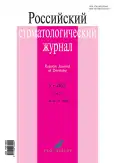Changes in the oral microbioty with losing teeth
- 作者: Malyshev M.E.1,2, Kerimkhanov K.А.3, Iordanishvili A.K.4, Bumay A.О.1,2
-
隶属关系:
- Saint Petersburg State University
- Research Institute of Emergency Medicine named after I.I. Dzhanelidze
- Medical center “MedIs”
- Military Medical Academy named after S.M. Kirov
- 期: 卷 26, 编号 5 (2022)
- 页面: 381-387
- 栏目: Clinical Investigation
- URL: https://journals.rcsi.science/1728-2802/article/view/232562
- DOI: https://doi.org/10.17816/dent109032
- ID: 232562
如何引用文章
详细
BACKGROUND: The influence of the presence/absence of teeth and periodontium preserved at their existence as a balance factor in the oral cavity including the local immunity of the mucous membranes is practically not reported in the literature.
AIM: The study aimed to examine the microbial community of the oral cavity at the loss of natural teeth.
MATERIAL AND METHODS: Forty-five individuals aged 61–74 years were under observation and divided into three study groups. The control group had partial loss of natural teeth. Group 2 had partial loss of teeth on both jaws and suffered from severe chronic generalized periodontitis. Group 3 had partial tooth loss on both jaws and suffered from chronic periapical inflammatory processes (chronic granulomatous periodontitis) in the absence of acute, chronic, or exacerbation of the chronic inflammatory process in periodontal tissues. In this study group, all upper and lower jaw teeth were extracted for oral sanitation before orthodontic treatment. The microbiota was assessed before surgical sanitation of the oral cavity (before tooth extraction) and 30–35 days after the last tooth extraction, i.e., at complete tooth loss on the upper and lower jaws.
RESULTS: On initial examination, the detection frequency of five red complex periodontopathogens (Prevotella intermedia, Bacteroides forsythus, Treponema denticola, Actinobacillus actinomycetemcomitans, and Porphyromonas gingivalis) ranged from 27% to 53%, which was significantly higher than that of the control group (13%–27%). In 1 month after complete tooth extraction, the detection of these microorganisms in the experimental groups (with periodontitis and periodontitis) reliably decreased (P. intermedia, 20%; B. forsythus, 20%; T. denticola, 20%; A. actinomycetemcomitans, 20%; P. gingivalis, 33%), which was not significantly different from that of the control group.
CONCLUSION: Complete extraction of teeth did not affect the presence of Staphylococcus spp. and Streptococcus spp. in the saliva of patients with periodontal diseases but led to a significant reduction in the presence of periodontopathogens and Candida sp. in the saliva of older people.
作者简介
Mikhail Malyshev
Saint Petersburg State University; Research Institute of Emergency Medicine named after I.I. Dzhanelidze
Email: Malyshev1972@yandex.ru
ORCID iD: 0000-0001-7549-682X
MD, Dr. Sci. (Biol.), Professor
俄罗斯联邦, Saint Petersburg; Saint PetersburgKamil Kerimkhanov
Medical center “MedIs”
Email: 1yadakamil@mail.ru
ORCID iD: 0000-0002-9149-2631
俄罗斯联邦, Saint Petersburg
Andrey Iordanishvili
Military Medical Academy named after S.M. Kirov
编辑信件的主要联系方式.
Email: professoraki@mail.ru
ORCID iD: 0000-0003-0052-3277
MD, Dr. Sci. (Med.), Professor
俄罗斯联邦, Saint PetersburgAleksey Bumay
Saint Petersburg State University; Research Institute of Emergency Medicine named after I.I. Dzhanelidze
Email: bumay_ao@list.ru
俄罗斯联邦, Saint Petersburg; Saint Petersburg
参考
- Malyshev ME, Lobeiko VV, Iordanishvili AK. Immune parameters of saliva in persons of different age living in St. Petersburg and Leningrad region. Advances in Gerontology. 2015;28(2):294–298. (In Russ).
- Lo CH, Nguyen LH, Wu K, et al. Periodontal Disease, Tooth Loss, and Risk of Serrated Polyps and Conventional Adenomas. Cancer Prev Res (Phila). 2020;13(8):699–706. doi: 10.1158/1940-6207.CAPR-20-0090
- Hajishengallis G. Periodontitis: from microbial immune subversion to systemic inflammation. Nat Rev Immunol. 2015;15(1):30–44. doi: 10.1038/nri3785
- Hajishengallis G, Korostoff JM. Revisiting the Page & Schroeder model: the good, the bad and the unknowns in the periodontal host response 40 years later. Periodontol 2000. 2017;75(1):116–151. doi: 10.1111/prd.12181
- Papapanou PN, Sanz M, Buduneli N, et al. Periodontitis: Consensus report of workgroup 2 of the 2017 World Workshop on the Classification of Periodontal and Peri-Implant Diseases and Conditions. J Clin Periodontol. 2018;45(Suppl. 20):S162–S170. doi: 10.1111/jcpe.12946
- Hajishengallis G, Lamont RJ. Beyond the red complex and into more complexity: the polymicrobial synergy and dysbiosis (PSD) model of periodontal disease etiology. Mol Oral Microbiol. 2012;27(6):409–419. doi: 10.1111/j.2041-1014.2012.00663.x
- Marsh PD. Microbial ecology of dental plaque and its significance in health and disease. Adv Dent Res. 1994;8(2):263–271. doi: 10.1177/08959374940080022001
- Socransky SS, Haffajee AD, Cugini MA, et al. Microbial complexes in subgingival plaque. J Clin Periodontol. 1998;25(2):134–144. doi: 10.1111/j.1600-051x.1998.tb02419.x
- Hajishengallis G, Liang S, Payne MA, et al. Low-abundance biofilm species orchestrates inflammatory periodontal disease through the commensal microbiota and complement. Cell Host Microbe. 2011;10(5):497–506. doi: 10.1016/j.chom.2011.10.006
- Dutzan N, Konkel JE, Greenwell-Wild T, Moutsopoulos NM. Characterization of the human immune cell network at the gingival barrier. Mucosal Immunol. 2016;9(5):1163–1172. doi: 10.1038/mi.2015.136
- Abusleme L, Dupuy AK, Dutzan N, et al. The subgingival microbiome in health and periodontitis and its relationship with community biomass and inflammation. ISME J. 2013;7(5):1016–1025. doi: 10.1038/ismej.2012.174
- Haubek D, Ennibi OK, Poulsen K, et al. Risk of aggressive periodontitis in adolescent carriers of the JP2 clone of Aggregatibacter (Actinobacillus) actinomycetemcomitans in Morocco: a prospective longitudinal cohort study. Lancet. 2008;371(9608):237–242. doi: 10.1016/S0140-6736(08)60135-X
- Cai Z, Lin S, Hu S, Zhao L. Structure and Function of Oral Microbial Community in Periodontitis Based on Integrated Data. Front Cell Infect Microbiol. 2021;11:663756. doi: 10.3389/fcimb.2021.663756
- Tan KH, Seers CA, Dashper SG, et al. Porphyromonas gingivalis and Treponema denticola exhibit metabolic symbioses. PLoS Pathog. 2014;10(3):e1003955. doi: 10.1371/journal.ppat.1003955
- Daep CA, Novak EA, Lamont RJ, Demuth DR. Structural dissection and in vivo effectiveness of a peptide inhibitor of Porphyromonas gingivalis adherence to Streptococcus gordonii. Infect Immun. 2011;79(1):67–74. doi: 10.1128/IAI.00361-10
- Inenaga C, Hokamura K, Nakano K, et al. A potential new risk factor for stroke: streptococcus mutans with collagen-binding protein. World Neurosurg. 2018;113:e77–e81. doi: 10.1016/j.wneu.2018.01.158
- Glurich I, Acharya A, Shukla SK, et al. The oral-systemic personalized medicine model at Marshfield Clinic. Oral Dis. 2013;19(1):1–17. doi: 10.1111/j.1601-0825.2012.01921.x
- Malyshev ME, Iordanishvili AK, Musheghyan PA, Khabirova TG. State of oral secretory immunity in patients with Candida-associated prosthetic stomatitis. Medical Immunology. 2021;23(3):577–584. (In Russ). doi: 10.15789/1563-0625-SIS-2230
补充文件







